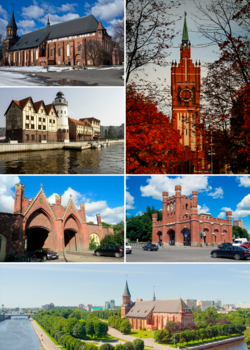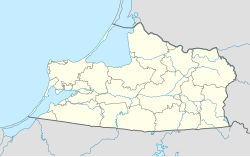
Back Kaliningrad Afrikaans ካሊኒንግራድ Amharic Cyningesbeorg ANG كالينينغراد Arabic كالينينجراد ARZ Kaliningráu AST Kalininqrad Azerbaijani کالینینقراد AZB Калининград Bashkir Kaliningrad BAN
Kaliningrad
Калининград | |
|---|---|
 Church of the Holy Family; Königsberg Cathedral; "Fishermen's village" in pseudo-historic style; Brandenburg Gate; King's Gate; Pregolya River | |
|
| |
| Coordinates: 54°42′01″N 20°27′11″E / 54.70028°N 20.45306°E | |
| Country | Russia |
| Federal subject | Kaliningrad Oblast[1] |
| Founded | 1 September 1255[2] |
| Government | |
| • Body | City Council of Deputies[3] |
| • Head[3] | Elena Ivanovna Dyatlova[4] |
| Area | |
• Total | 223.03 km2 (86.11 sq mi) |
| Elevation | 5 m (16 ft) |
| Population | |
• Total | 431,402 |
• Estimate (January 2018)[6] | 475,056 |
| • Rank | 40th in 2010 |
| • Density | 1,900/km2 (5,000/sq mi) |
| • Subordinated to | city of oblast significance of Kaliningrad[1] |
| • Capital of | Kaliningrad Oblast,[7] city of oblast significance of Kaliningrad[1] |
| • Urban okrug | Kaliningrad Urban Okrug[8] |
| • Capital of | Kaliningrad Urban Okrug[8] |
| Time zone | UTC+2 (MSK–1 |
| Postal code(s)[10] | 236001 - 236999 |
| Dialing code(s) | +7 4012 |
| OKTMO ID | 27701000001 |
| City Day | 4 July; observed on the first Saturday of July |
| Website | klgd |
Kaliningrad,[a] known as Königsberg[b] until 1946, is the largest city and administrative centre of Kaliningrad Oblast, a Russian exclave between Lithuania and Poland. The city sits about 663 kilometres (412 mi) west of the bulk of Russia. The city is situated on the Pregolya River, at the head of the Vistula Lagoon on the Baltic Sea, and is the only ice-free Russian port on the Baltic Sea. Its population in 2020 was 489,359.[11] Kaliningrad is the second-largest city in the Northwestern Federal District, after Saint Petersburg, the third-largest city in the Baltic region, and the seventh-largest city on the Baltic Sea.
Modern-day Kaliningrad was renamed, rebuilt and repopulated by Russians starting in 1946 in the ruins of Königsberg, in which only Lithuanian inhabitants were allowed to remain. Meanwhile, the German population was ethnically cleansed, in effect creating a new city. Königsberg itself had been founded in 1255 on the site of the ancient Old Prussian settlement Twangste by the Teutonic Knights during the Northern Crusades, and named Königsberg in honor of King Ottokar II of Bohemia. A Baltic port city, it successively became the capital of the State of the Teutonic Order, the Duchy of Prussia (1525–1701) and East Prussia.
Königsberg remained the coronation city of the Prussian monarchy, though the capital was moved to Berlin in 1701. From 1454 to 1455, the city under the name of Królewiec belonged to the Kingdom of Poland, and from 1466 to 1657 it was a Polish fief. Königsberg was the easternmost large city in Germany until World War II. The city was heavily damaged by Allied bombing in 1944 and during the Battle of Königsberg in 1945; it was then captured by the Soviet Union on 9 April 1945. The Potsdam Agreement of 1945 placed it under Soviet administration. The city was renamed Kaliningrad in 1946 in honor of Russian Bolshevik leader Mikhail Kalinin.
Since the dissolution of the Soviet Union, Kaliningrad has been governed as the administrative centre of Russia's Kaliningrad Oblast, the westernmost oblast of Russia.[12] As a major transport hub, with sea and river ports, the city is home to the headquarters of the Baltic Fleet of the Russian Navy, and is one of the largest industrial centres in Russia.[13] It was deemed the best city in Russia in 2012, 2013, and 2014 in Kommersant's magazine The Firm's Secret,[14] the best city in Russia for business in 2013 according to Forbes,[15] and was ranked fifth in the Urban Environment Quality Index published by Minstroy in 2019.[16] Kaliningrad has been a major internal migration attraction in Russia over the past two decades,[17] and was one of the host cities of the 2018 FIFA World Cup.
- ^ a b c d Cite error: The named reference
Ref648was invoked but never defined (see the help page). - ^ a b Official website of Kaliningrad. Passport of Kaliningrad Urban Okrug. (in Russian)
- ^ a b Charter of Kaliningrad, Article 25
- ^ Official website of Kaliningrad. Head of the City, Alexander Georgiyevich Yaroshuk. (in Russian)
- ^ Russian Federal State Statistics Service (2011). Всероссийская перепись населения 2010 года. Том 1 [2010 All-Russian Population Census, vol. 1]. Всероссийская перепись населения 2010 года [2010 All-Russia Population Census] (in Russian). Federal State Statistics Service.
- ^ Kaliningrad Oblast Territorial Branch of the Federal State Statistics Service. Оценка численности населения Калининградской области по состоянию на 1 января 2018 года[permanent dead link] (in Russian)
- ^ Cite error: The named reference
Ref253was invoked but never defined (see the help page). - ^ a b Cite error: The named reference
Ref719was invoked but never defined (see the help page). - ^ "Об исчислении времени". Официальный интернет-портал правовой информации (in Russian). June 3, 2011. Retrieved January 19, 2019.
- ^ Почта России. Информационно-вычислительный центр ОАСУ РПО. (Russian Post). Поиск объектов почтовой связи (Postal Objects Search) (in Russian)
- ^ "Russia: Severo-Zapadnyj Federal'nyj Okrug: Northwestern Federal District". City Population.de. August 8, 2020. Retrieved August 28, 2020.
- ^ В.И. Кулаков, Д.А. Пуляева. "Кaliningrad". Большая российская энциклопедия. Archived from the original on June 7, 2019. Retrieved August 4, 2020.
- ^ Alexander Akishin (December 16, 2013). "250 крупнейших промышленных центров России". Urbanica. Retrieved July 30, 2020.
- ^ "100 лучших городов России". Kommersant Secret Firmy. April 2, 2013. Retrieved July 31, 2020.
- ^ "30 лучших городов для бизнеса 2013". Forbes. Retrieved July 31, 2020.
- ^ Кирилл Алексеев (November 5, 2019). "Рейтинг комфортности городов России: Пионерский на первом месте, Калининград - на пятом". Kaliningrad.kp.ru -. Komsomolskaya Pravda. Retrieved August 4, 2020.
- ^ "Калининград включили в список крупнейших центров миграционного притяжения". Klops. June 27, 2014. Retrieved August 4, 2020.
Cite error: There are <ref group=lower-alpha> tags or {{efn}} templates on this page, but the references will not show without a {{reflist|group=lower-alpha}} template or {{notelist}} template (see the help page).





